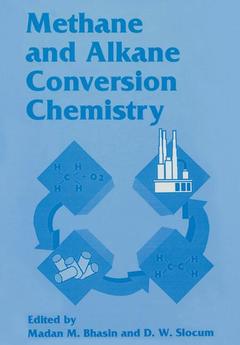Methane and Alkane Conversion Chemistry, Softcover reprint of the original 1st ed. 1995
Langue : Anglais
Coordonnateurs : Bhasin M.M., Slocum D.W.

Natural gas, an abundant natural energy and chemical resource, is underutilized. Its inherent high energy content is compromised by its volatility. Storage and transportation problems abound for liquified natural gas. Several of the drawbacks of the utilization of natural gas, particularly its high volatility, could be offset by development of an economical and efficient process for coupling and/or further homologation of its principal component, methane. Alternatively, other conversion strategies such as partial oxidation to methanol and syngas, to oxygenates or conversion to such products via the intermediacy of chlorides should also be considered. Given the energy-intensive regimes necessary for the likely activation of methane, it was inevitable that researchers would tum to the use of heterogeneous catalysts. Heterogeneous catalysis is now a relatively mature discipline with numerous and diverse reactions being explored alongside informative studies on surface characterization, mechanism, and theory. Relationships to important related areas such as homogeneous catalysis, organometallic chemistry, and inorganic chemistry have become firmly established within this discipline. The field of methane and alkane activation is now over ten years old. The first decade of investigation produced results plagued by low yields and low-moderate conversions with well-articulated mechanistic limitations. As we begin the second decade of inquiry, novel strategies have brought increasing yields and conversions to such products as ethane, ethylene, methanol, and formaldehyde. These new approaches utilize separation of products via membranes or adsorbents. Moreover, additional mechanistic insight has been forthcoming from theoretical and computational examination as well as experimental investigation.
Gas Conversion: Methane and Alkane Activation Chemistry: Oxidative Coupling of Methane-A Progress Report (M.M. Bhasin et al.). Methane and Light Alkane (C2C4) Conversion over Metal Fluoride-Metal Oxide Catalyst System in Presence of Oxygen (H.L. Wan et al.). Oxidative Coupling of Methane over Sulfated Sr/La2O3 Catalysts (R. Herman et al.). The Oxidative Coupling of Methane over ZrO2, Doped Li/MgO Catalysts (G.C. Hoogendam et al.). Mechanism and Modeling of Methanerich Oxidation: Effect of Diffusion Limitations of Surface Produced Radicals on the C2 Selectivity in the Oxidative Coupling of Methane (G.B. Marin et al.). Effects of Product Separation on the Kinetics and Selectivity of Oxidative Coupling (R.B. Hall et al.). Reactive vs. Adsorbed Oxygen in Heterogeneous Oxidation of Methane over Li/MgO (A.J. Colussi et al.) Methane to Oxygenates and Chemicals: Selective Photooxidation of Methane to Formaldehyde Using Supported Group VB and VIB Oxide Catalysts (K. Wada et al.). A Study of the Iron/Sodalite Catalyst for the Partial Oxidation of Methane to Methanol (S. Betteridge et al.). Partial Oxidation of Methane to Formaldehyde over Vanadia Catalysts: Reaction Mechanism (B.K. Hodnett). 27 additional articles. Index.
Date de parution : 10-2012
Ouvrage de 349 p.
17x24.4 cm
Disponible chez l'éditeur (délai d'approvisionnement : 15 jours).
Prix indicatif 52,74 €
Ajouter au panierThèmes de Methane and Alkane Conversion Chemistry :
Mots-clés :
Chlor; catalysis; chemistry; inorganic chemistry; methanol; organic chemistry
© 2024 LAVOISIER S.A.S.
